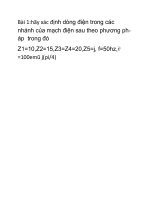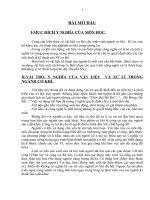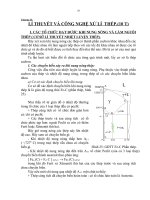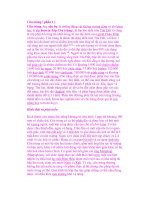Designing Autonomous Mobile Robots phần 1 pps
Bạn đang xem bản rút gọn của tài liệu. Xem và tải ngay bản đầy đủ của tài liệu tại đây (380.58 KB, 36 trang )
Designing Autonomous
Mobile Robots
by John Holland
AMSTERDAM • BOSTON • HEIDELBERG • LONDON
NEW YORK • OXFORD • PARIS • SAN DIEGO
SAN FRANCISCO • SINGAPORE • SYDNEY • TOKYO
Designing Autonomous
Mobile Robots
Newnes is an imprint of Elsevier
200 Wheeler Road, Burlington, MA 01803, USA
Linacre House, Jordan Hill, Oxford OX2 8DP, UK
Copyright © 2004, Elsevier Inc. All rights reserved.
No part of this publication may be reproduced, stored in a retrieval system, or transmitted in
any form or by any means, electronic, mechanical, photocopying, recording, or otherwise,
without the prior written permission of the publisher.
Permissions may be sought directly from Elsevier’s Science & Technology Rights Department in
Oxford, UK: phone: (+44) 1865 843830, fax: (+44) 1865 853333, e-mail:
You may also complete your request on-line via the Elsevier
homepage (), by selecting “Customer Support” and then “Obtaining
Permissions.”
Recognizing the importance of preserving what has been written, Elsevier prints its books on
acid-free paper whenever possible.
Library of Congress Cataloging-in-Publication Data
(Application submitted.)
British Library Cataloguing-in-Publication Data
A catalogue record for this book is available from the British Library.
ISBN: 0-7506-7683-3
For information on all Newnes publications
visit our website at www.newnespress.com
03 04 05 06 07 08 10 9 8 7 6 5 4 3 2 1
Printed in the United States of America
Dedication
This book is dedicated to all the employees, board members, stockholders and
supporters of Cybermotion over all the years. How I should ever have been lucky
enough to work with so many dedicated, talented, intelligent, humorous and
tenacious people I shall never know. All of the challenges we faced together have
produced these pages, I merely did the typing. In fairness, it must also be dedicated
to the long suffering spouses of the “Cyberdogs,” including my own wonderful wife
Sheilah.
vii
Contents
Foreword xiii
What’s on the CD-ROM? xv
SECTION 1 – Background Software and Concepts 1
Chapter 1: Measure Twice, Cut Once 3
Determinism 3
Rule-based systems, state-driven systems, and other potential tar pits 4
Defining an open architecture 10
Chapter 2: A Brief History of Software Concepts 11
Assembly language 12
Early conventional languages 13
Compilers vs. interpreters 15
The GUI revolution 17
The great rift 18
Object-oriented programming 18
Robots and robot subsystems as objects 20
Network languages 21
Chapter 3: The Basics of Real-time Software (For Mere Mortals) 23
Threads 23
Interrupts and stacks 24
Context 26
viii
Contents
Kernels and tasks 28
Task switching 31
Interrupt events 31
Time slicing 32
Reentrance 32
Interrupt masking and interrupt priority 33
Inter-task communications 34
Visual Basic and real-time controls 35
VB events 35
DoEvents 35
Freddy as a VB form 38
Modal controls 40
Some other tips on using VB for real-time applications 40
Setting up a structure 40
Creating a library 41
Chapter 4: Thinking More Clearly Through Fuzzy Logic 45
Trapezoidal fuzzy logic 49
Fuzzy democracy 50
Adaptive fuzzy logic 51
Weighting trapezoids in response to other parameters 51
Multipass and fratricidal fuzzy logic 53
Summary 54
Chapter 5: Closed Loop Controls, Rabbits and Hounds 55
Basic PID controls 58
Predictive controls 63
Combined reactive and predictive controls 64
Various PID enhancements 65
Robot drive controls 69
Tuning controls 73
Rabbits chasing rabbits 75
Conclusions 75
ix
Contents
Chapter 6: Communications and Control 77
Popular networks 77
Rigid protocols and other really bad ideas 81
Flexible protocols 85
Communications architectures 88
Wrappers, layers, and shells 89
Drivers, OCXs and DLLs 93
Improving communications efficiency 95
Timing issues and error handling 99
Other issues 103
SECTION 2 – Basic Navigation 105
Chapter 7: Basic Navigation Philosophies 107
The academic school of thought 107
The industrial school of thought 109
Area coverage robots 109
Virtual path following vs. goal seeking 111
A practical starting point and “a priori” knowledge 115
Chapter 8: Live Reckoning 117
Understanding why good dead reckoning is crucial 120
Picking coordinate systems 121
Tick calculations 122
Live reckoning interaction with other processes 126
Chapter 9: The Best Laid Plans of Mice and Machines 127
Path planning and execution 128
Are we there yet? 130
Running on 132
Bread crumbs and irregular path following 132
The Z axis, maps, and wormholes 134
Summary 135
x
Contents
Chapter 10: Navigation as a Filtering Process 137
Filtering for the truth 137
The importance of uncertainty 138
Modeling uncertainty 140
Reducing uncertainty 143
Learning to be accurately uncertain 144
Uses of uncertainty 144
Chapter 11: Hard Navigation vs. Fuzzy Navigation 145
Sensor data and maps 145
Navigation features 147
Hard navigation 149
The concept of fuzzy navigation 151
Other profiles 164
The referenced state 165
Reducing uncertainty 166
Chapter 12: Sensors, Navigation Agents and Arbitration 169
Sensor types 169
Guidelines for selecting and deploying navigation and
collision avoidance sensors 178
Navigation agents 186
Agent properties and methods 186
Arbitration and competition among agents 187
Who to believe 188
Changing one’s mind 189
Summary 189
Chapter 13: Instilling Pain, Fear and Confidence 191
Pain and annoyance 191
Virtual pain 191
Avoiding pain and humiliation 194
The purpose of virtual confidence 198
xi
Calculating virtual confidence 200
Summary 207
Chapter 14: Becoming Unstuck in Time 209
Getting past sequential thinking 209
Thinking of a mobile robot as multiple robot time-places 214
Managing the time dimension 217
Chapter 15: Programming Robots to Be Useful 219
Preprogramming vs. teaching paths 219
Embedding data into maps 222
Map interpreters 223
Events and targets 224
Text-based programming 226
Graphical generation of text programs 231
Conclusions 237
Chapter 16: Command, Control, and Monitoring 239
Unmanaged and self-managed systems 240
Ping-pong job management 242
Dispatched job management 243
Exceptions 248
Exception decision making 251
Expert assistance 253
Status monitoring 254
Taking control 255
Some GUI rules 257
Robustness and context preservation 261
Conclusions 261
Chapter 17: The Law of Conservation of Defects
and the Art of Debugging 263
The law of conservation of defects 263
The art of debugging 267
Contents
xii
Types of bugs 272
Summary 274
Chapter 18: “What the Hell Happened?” 275
Logging 278
Data mining using relational techniques 282
Incident reporting 290
Summary 294
Chapter 19: The Industry, Its Past and Its Future 295
The history of robotics 296
The mobile robotics industry 300
Industry segmentation for autonomous mobile robots 302
The government sector 309
Why aren’t the robots here yet? 318
The future 321
Appendix: Referenced Laws and Formulas 325
Law of Sines and Law of Cosines 325
Simple 2D Vector Addition 326
Linear Regression 327
About the Author 329
Index 331
Contents
xiii
Foreword
One of the most exciting challenges a designer can face is that of building a practical
autonomous mobile robot. This is as close as we mere mortals can come to producing
a living being. Make no mistake; we are talking about very primitive beings, but
artificial beings nonetheless. Autonomous robots exist today that can perform
complex tasks without human assistance for weeks or even months, but these robots
will seem laughably crude in the years to come.
The building blocks for autonomous robots have been readily available for several
years. Powerful microprocessors, laser-based sensors (lidar), Ethernet radio commu-
nications, video processors, and a host of other subsystems are now priced at levels
that permit practical autonomous machines to be built for an exciting range of
commercially viable applications. There are even a wide range of simple sensors and
actuators that allow the hobbyist to develop small, but sophisticated robots.
The challenge is in understanding how these systems can be made to play together
in a coherent and effective way to create a system that is far more than the sum of its
parts. If the designer thinks of a new robot design as being laser-guided, or as using
GPS navigation, the result will be a design that is inflexible. Such a design may be
useful, but it will be not able to grow beyond its initial concept. A stripe following
“Automatic Guided Vehicle” is an excellent example of such a design. Autonomous
robots are much more robust and interesting beasts.
It is my experience that any good concept will have an intrinsic elegance. A good
software and hardware structure is like a snowflake, with each subsystem having the
same basic structure as every other subsystem. At the center, a few basic structures
hold it all together. Each point of the snowflake will have differences from the
others, but will follow the same basic pattern.
xiv
This is not a book full of complex equations. Everything you need to know about
math you learned in geometry class. Nor is this a book about how to build a robot.
Instead, this is a book about how to organize a robot design so that building it
follows naturally. Robot design is not so much about inventing as it is about redis-
covering. The concepts are all familiar; they just need to be placed into a snowflake.
The ideas presented here are based on 18 years of robot design experience. There
can be no doubt that others have discovered many of these concepts and given them
different names. As I have said, this is about discovery as much as it is about inven-
tion. Let me apologize in advance if I have failed to give anyone credit here.
Finally, designing an autonomous robot teaches us many priceless lessons, not the
least of which is a deep humility and appreciation of the miracle of the simplest
living creatures. Yet for me, there is nothing that compares to the thrill of turning
your creation loose to fend for itself! Once you have mastered these concepts, you
will be able to approach the design of any complex control system with complete
confidence.
Foreword
xv
Included on the accompanying CD-ROM:
■
A full searchable eBook version of the text in Adobe pdf format
■
A directory containing the sourcecode for all of the example programs
in the book
Refer to the ReadMe file for more details on CD-ROM content.
What’s on the CD-ROM?
Section 1:
Background Software Concepts
Measure Twice, Cut Once
1
CHAPTER
3
The chances are pretty good that you wouldn’t have picked up this book unless you
already had a strong motivation to push the envelope and create a marvelous new
machine. You may have already created one or more robots and are anxious to put
your experience in perspective and do it all again. You are probably anxious to get
on with bending metal and writing code as soon as possible.
As mentioned in the preface, this is not a book about “How to Build” a robot. If it
were, you could simply copy some instructions and be building your machine imme-
diately. Instead, this book is about how to organize your approach so that you can
begin to create innovative machines that can react to ever-changing conditions to
perform useful tasks. The difference is that between being an artist, and being great
at paint-by-numbers.
Determinism
And why is designing a mobile robot so much more complex than, say, writing an
accounting program? In scale it may not be, but the inputs to most software applica-
tions are of finite variety, and calculations are absolute. There is only one correct
balance for a column of numbers. Even complex graphics programs have only one set
of outputs for any given set of inputs.
With a mobile robot, however, the input combinations change every time it runs
a path. Nothing stays constant in the physical world, and nothing looks the
same twice in a row. So nearly infinite are the combination of stimuli to which a
sensor-based robot may be exposed that its behavior can be described as virtually
nondeterministic. In other words, it appears that the exact behavior of the system
cannot be predicted from merely observing its operation and the environment. The
4
Chapter 1
keyword here is “virtually,” since the permutations of stimuli and reactions become
too convolved for prediction through even the most enlightened observation.
When we truly begin to grasp this fact, the whole process of programming autono-
mous systems takes on an almost metaphysical dimension. Input data can no longer
be processed at face value, but must be filtered in relation to other data, and accord-
ing to experiences of the recent past. In the process of doing this, we begin to see
our own human behavior in a new light. Fear and caution, for example, begin to
look like excellent control modification mechanisms, and not merely human
emotions.
Given the complexity of the task ahead, we must plan our approach carefully. The
second most frustrating phase of any complex project is determining the architecture
to be used. The first most frustrating phase is realizing after months of trying to
implement a flawed architecture that it has degenerated into a mass of patches and
expedients, that it has lost any semblance of elegance, and that it will have to be
razed to the ground and rebuilt.
While developing our architecture, we try to think of all the various capabilities we
will need and vaguely how they will be performed in hardware and software, and
then envision a structure that can be used to tie them together. We then think of
things that could go wrong, and challenge our ephemeral structure. This often causes
the rickety conceptual framework to crash to the ground, but each time it does so
we build anew with more robust geometries. Often a vicious circle of reasoning will
be encountered which repeatedly flips us from one approach to another, only to be
pushed back again by complex considerations, but with single-minded persistence
our architecture will eventually emerge.
I will warn of as many traps as I can, but others you will have to find yourself. Just
remember that you always need a “Plan B.” That is, you must always keep in mind
how you will adapt your approach if one or more elements prove flawed.
Rule-based systems, state-driven systems, and other potential tar pits
To some extent, rule-based systems and state-driven systems are simply opposite
sides of the same coin. In its simplest form, a state-driven system attempts to provide
a discrete block of instructions (rules) that define the machine’s reaction to its
inputs for a given state or circumstance. It is almost inevitable that any architecture
will have elements of such a structure, but appropriately defining the states is the key.
5
Measure Twice, Cut Once
As an example of how quickly a purely state-driven system can become unwieldy,
let’s look at a very primitive robot. In our example, the robot has two forward-
looking sonar detectors to provide collision avoidance, and it has two modes: “Off”
and “Drive.” We will assume it can only drive forward. To simplify the issue even
more, we will forget about navigation and assume we simply want it to keep moving.
Now let’s solve the problem with a discrete, single level, state-driven solution.
Single level simply means that there will be no states within states. We determine
that there are the following states:
L>Dmax
State and
Number Mode R>Dmax L<R R<L Behavior
1 OFF NC NC NC Turn motors off
2 FORWARD X Accelerate forward
3 FORWARD x Turn right while decelerating
4 FORWARD x Turn left while decelerating
Figure 1.1. Simple robot with two sonar sensors
Robot
L R
D
max
D
stop
Table 1.1. Simple states for robot of Figure 1.1
6
Chapter 1
Coded as a simple linear program, the program flow would resemble that shown in
Figure 1.2. The first task gets the sonar ranges. The robot’s mode and the ranges are
then tested to determine the state. The State 3 and 4 functions will calculate the
robot’s rate of turning, and its acceleration or deceleration.
State 1 simply decelerates at the highest safe rate to bring the robot to a halt if it is
not already halted. State 2 (all clear) accelerates the robot while steering straight
ahead, and states 3 and 4 cause the robot to turn while decelerating. These functions
must continuously recalculate the deceleration so that the robot will come to a halt
if and when either sonar range becomes less than the programmed stopping distance
(Dstop).
The desired result for State 3 and 4 behaviors is for the robot’s path to arc at an in-
creasingly tight angle as it approaches a target because the speed is decreasing as the
steering rate is increasing. Hopefully, the target will eventually pass away to the side
of the sonar transducer pattern, State 2 will become active, and our robot will
continue on its way.
Range
Test
Mode
Test
Get Sonar
Ranges
State 2
Accelerate
Straight
Ahead
State3
Decelerate
and Turn
Right
State 1
Decelerate
to Halt
State 4
Decelerate
and Turn
Left
Run Motors
and do other
Housekeeping
Mode = OFF
L > D
max
R > D
max
and
R < L
L < R
Figure 1.2. Program flow for robot of Figure 1.1
7
Measure Twice, Cut Once
So what could go wrong? The answer is just about everything! The first problem has
to do with timing. If the task that gets the sonar ranges is actually running the sonar,
or it must wait for the ranges to be determined by another system, then the length of
time required to process the range information will vary depending on conditions.
Furthermore, the calculations of the various states will take variable amounts of
time. The reason that this is important is that the states must calculate accelerations
and velocities, and to do this they must be related to a consistent time base.
The final task of running the motors will be executing a control program that will
also require consistent timing. It is therefore necessary that the program loop at a
constant and known rate so that these calculations can be made. Reading a hard-
ware clock is not an option, as the sampling rate of the system needs to be constant
to assure stability. If the reader is familiar with filter theory, all of this will sound
very familiar! The simplest solution to the problem of achieving constant timing is
to eliminate the loop back to the top of the process, and execute the whole process
from a timer interrupt.
If we assume that the process is timer driven, it will be necessary to assure that the
task is completed before the timer fires again. If the timer starts again before calcula-
tions are complete, then partially calculated parameters may be overwritten and
contaminated. A task like this one is thus said to be nonreentrant. Worse yet, re-
peatedly reentering a nonreentrant task can cause the processor to eventually
overflow its stack and crash. This can cause very strange and unwelcome behavior in
our little appliance.
Next consider the “straw man” scenario of Figure 1.3. Here our robot encounters a
target on its left side (State 3), begins turning right, drives into the path of a target
on that side at an even closer range (State 4). As it turns away from the target on
the right, it goes back into State 3. The result is that the robot drives forward so that
the closer target approaches along the right edge of the right transducer pattern
until the robot comes to a halt, or worse, sideswipes the closer target (Figure 1.4).
It has already become apparent that our control architecture is flawed. We must
have a strategy for escaping from such a situation. One problem with our strategy is
that we are trying to solve the problem instantaneously, without regard to the recent
past. As soon as we begin to turn away from the closer target, we forget all about it,
and react to the further target again. Truly, a robot that doesn’t learn from history is
doomed to repeat it!
8
Chapter 1
Robot
L
R
We could elect to go in any of several directions with our simple robot. We could
provide latched states to take into account recent history. For example, we could
record the fact that the system had gone between states 3 and 4 without ever having
experienced a State 2 clear period. If this happened, we could force the robot to
continue to turn away from the nearer obstacle until State 2 was achieved.
To do this, the robot would have to essentially latch the behavior of State 4 (turn
left) if it occurred immediately after State 3. We could then unlatch State 4 if State
2 (Clear) or State 1 (Halt) conditions occurred. To do this we could introduce new,
persistent states called states 5 and 6. State 5 could be called “Escape Right” and
State 6 could be called “Escape Left.” A persistent state remains true unless can-
celled by a higher ranking state.
Figure 1.5 shows the logic flow for our simple collision avoidance robot as a modified
state-driven machine. Notice that we have gone from an instantaneous state ap-
praisal and reaction to a more complex decision tree in which some states must be
evaluated before others, and where the previous state may be maintained even if its
initial trigger conditions are no longer true. The logic no longer has the simple
elegance promised in the concept of a “state-driven” machine. The flow is already
getting convoluted, and we have yet to give the robot any real sense of objective!
Worse, there are still potential weaknesses in the performance. For example, there is
Figure 1.4. Robot becomes trapped
Robot
L R
Figure 1.3. Robot enters State 3
and begins turning right









